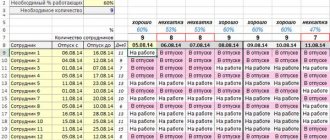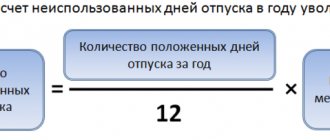How does the procedure for dismissing an employee take place and by what legal standards is it regulated?
It would seem that every working citizen knows the answer to this question.
But in reality, you can encounter nuances that will baffle even a legally literate person.
What does the law say about the need to work off upon dismissal? How is this period correctly calculated, and what days does it include? Is 2 weeks of work paid upon dismissal?
We will talk about this in detail in this article.
Obligation to work – what the law says
The Labor Code protects the interests of not only the employee, but also the employer. One of the guarantees that is provided to eliminate the risk of unplanned disruptions in the work process is the need to notify the manager in advance of the intention to leave the position in writing.
This obligation of the employee is enshrined in Art. 80 of the Labor Code of the Russian Federation - the manager must be notified of the planned departure 14 days before the actual end of work.
This 2 week period will allow the employee:
- complete current affairs;
- resolve issues regarding new employment.
For the manager, this is an opportunity to rearrange the work process in such a way that there is no downtime - transfer functions to another employee or find a new one.
After submitting an application signed by the resigning employee, the manager cannot influence his decision, since it is protected by law. Its functions include only issuing the relevant order on the specified date. On the last day of work, the employee is given his work book, which states the date and reason for dismissal, and a full payment is made.
Important
Note! The employer has no right to prevent an employee from resigning, even if a suitable replacement has not been found within 2 weeks.
When the obligation is removed
It is permissible not to fulfill the obligation to notify the employer upon dismissal at one’s own request when the following circumstances are present:
- start date;
- joining the army;
- loss of ability to work;
- retirement;
- moving to another city;
- decree;
- other situations that do not allow you to continue working.
This is also important to know:
Can a pregnant woman be fired from work: reasons for dismissal according to the Labor Code of the Russian Federation
Separately, the legislator identifies other circumstances that allow you to quit without working off. They are associated with violations of norms:
- non-payment or delay in payment of wages;
- denial of legal leave;
Such violations must be documented by authorized authorities:
- Labour Inspectorate;
- prosecutor's office;
- court.
In all of the above cases, the employee is fired on the day indicated by the application, without working off.
Who is exempt from mandatory service?
Almost all employees must work two weeks before the day of dismissal, however, there are special categories to which this requirement does not apply. These are the faces:
- with a trial period (only provided that this fact is reflected in the employment contract);
- those carrying out piecework work - citizens hired to perform a specific type or volume of work (minimum term of an employment agreement - 2 months);
- performing seasonal work at a specific time of year - in accordance with Art. 296 of the Labor Code, the duration of the employment contract must not exceed 2 months, and the activity carried out must be defined as seasonal.
These categories of employees are required to notify the employer of their intention to resign 3 calendar days in advance.
How many days in advance must you notify about leaving?
Dismissal with 2 weeks of work: how to calculate? The work must continue for two weeks.
It is 14 calendar days in advance that the employee needs to notify his manager of his desire to resign.
However, there are exceptions. Work off is 3 days in the following cases:
- If a person is on probation (Article 71 of the Labor Code of the Russian Federation).
- If a fixed-term employment contract was concluded for a period of no more than 2 months (Article 292 of the Labor Code of the Russian Federation).
But if the employee carried out seasonal agricultural work, then, based on Article 296 of the Labor Code of the Russian Federation, the working period is 7 days.
Dismissal procedure
Dismissal with 2 weeks of work is carried out according to the following algorithm:
- Notifying the employer of the intention to leave by submitting an appropriate application.
- Familiarization of the director with the application and determination of the last working day.
- Start of processing. If it is not clear from what day work begins upon dismissal, the days are counted from the day following the day the application was submitted.
- Publication of the order (in 2 copies).
- Making a full settlement - payment of all due compensation, including unused vacation.
- Registration and issuance of a work book, which already indicates the basis for termination of the employment relationship (“by agreement of the parties” or “at one’s own request”), order number and date. Certified by the signature of the director (or the person responsible for maintaining documentation) and the person resigning.
Norms of legal regulation of relations between employee and employer
The issue of the procedure for dismissal and the need for service, as well as its specific terms, is discussed in Article 80 of the Labor Code of the Russian Federation.
According to it, a period of two weeks for working out is designated as the “warning period for leaving a position.”
As such, the employee does not need to go to work on these days, and the law does not provide for it.
Having decided to quit, he can spend all these two weeks on unpaid leave without pay or on sick leave. The employer is obliged to find a replacement for him during this time.
If an employee to fill a vacant position was found earlier, the previous one, by agreement with the employer, will not have to fully work out this period. The main condition is that a new specialist must be invited to work for the company officially, in writing.
After the two-week notice period has expired, the employee has the right to stop working. After this period, the employer must pay the employee in full by issuing the original Work Book with a record of dismissal. The date of the employee’s actual departure from the company and the date of dismissal from the Labor Committee must coincide.
Example. The employee wrote a letter of resignation on December 3, 2015. This application was registered in the personnel service on December 3, 2015. The deadline will be counted from the day following the day the employer receives the original application. That is, from December 4, 2015. The end of the warning period in this case will be December 17, 2015. On this day, the final payment is made to the employee and all necessary documents are issued to him.
Submitting an application
Free legal consultation We will answer your question in 5 minutes!
Ask a Question
The first step to leaving the organization is for the employee to write a statement. Requirements for its preparation are not established, but there are points that must be included.
Free legal consultation
We will answer your question in 5 minutes!
Ask a Question
This is also important to know:
Continuous service after dismissal at will
This applies to the form of notification - you must notify yourself of your desire to resign in writing.
Notification can be:
- give to the director personally;
- leave it in the HR department;
- send by registered mail.
note
In the first 2 cases, it is advisable to draw up an application in 2 copies and give the document only with a note of acceptance. This will help avoid disputes over the timing of work and protect against situations where you have to work extra days.
Drawing up an application
To avoid problems with termination of employment, it is important to draw up the application correctly. There is no set form, but the document must indicate:
- details of the recipient (name of organization or full name/position of manager);
- information about the applicant (full name and position);
- date of registration;
- day of termination of the employment contract (determined by the employee);
- the reason for termination of employment can simply be indicated “at one’s own request.”
According to the law, the petition is not required to indicate a specific reason for leaving the company.
It is written in a formal style, taking into account the requirements of a business letter.
Sample application
A sample application is available
Is it possible to avoid mandatory order?
Article 80 of the Labor Code of the Russian Federation describes some circumstances in which the employer must necessarily agree with the employee’s desire to resign and not assign time off work. If the reasons are not stipulated by labor legislation, a citizen can still leave work without working off.
This is confirmed by the provision of Article 80 of the Labor Code of the Russian Federation, which establishes that by agreement of the employee and the employer, working hours may not be applied.
In his application, the employee should indicate his desire to resign without service and indicate a specific reason. When considering an application, the manager will most likely agree to meet with his subordinate if the reason for such a desire is objective. Typically, such circumstances include a desire to resign due to:
- with a change of residence;
- sending a spouse to work in another country;
- with the inability to perform duties for medical reasons;
- the need to care for a disabled person.
There may be other reasons, but the final decision will nevertheless be up to the employer. In any case, you will not have to perform work duties even if work is assigned if the person goes on sick leave or takes a vacation.
Procedure for calculating the working period
How to calculate the period that needs to be worked before actually leaving the company?
Standard processing times apply - 14 calendar days must pass.
The countdown starts from the moment the application is accepted and registered (by the director or the personnel department). The day of dismissal and actual end of employment will be the 14th calendar day.
Examples of calculations
The application was written on July 15, 2021 and registered on the same day, which means that two weeks of work begin on July 16. The last working day is July 30.
This is also important to know:
Resign by agreement of the parties - how to terminate by agreement
From what date is work counted for later registration of an application? If it was compiled on April 10, 2021, but sent by registered mail, it will take time for delivery and registration. For example, a document will be registered on April 21, 2018, which means that the countdown of days will begin on April 22, 2021. The last day of work is May 5, 2021.
Accounting for weekends and holidays
Separately, it is worth considering accounting for non-working days. The legislation does not directly indicate that they are not counted when determining two weeks. Therefore, the manager’s demand to work extra days is unlawful.
The working period is calculated in calendar days. But when this period expires on a non-working day, the contract is canceled on the next working day. This rule also applies when holidays fall.
Example of calculation with holidays
The resignation was submitted on December 20, 2021. The last day of work is January 4 (if the document is registered immediately and the countdown starts from December 21). It is impossible to formalize dismissal in 2018; the agreement ends in January 2021. But January 4 is a holiday, which means that the work book will be issued only on the 8th (on the first working day after the New Year holidays).
The employer is obliged to dismiss the employee after this period, even if he actually worked fewer days.
If an employee goes on sick leave
If an employee opens a certificate of incapacity for work during the working period, this does not change the order of counting the days before actual departure. The director must not only release the employee from his position on time, but also make all required payments after the end of the sick leave.
This is also important to know:
How to calculate average daily earnings
All days spent on sick leave are counted as part of the working period.
Free legal consultation We will answer your question in 5 minutes!
Call: 8 800 511-39-66
An employee has the right to apply for payment of a certificate of incapacity for work within 1 month after leaving the organization. He will receive 60% of his standard salary (assuming he has not already taken a job with another company).
Free legal consultation
We will answer your question in 5 minutes!
Ask a Question
This is a good opportunity for a resigning employee to avoid performing his duties for two weeks, while receiving additional compensation. Many people take advantage of this opportunity, especially if the relationship with the director is not very good.
Cases when you do not need to work 2 weeks and who may not work them
Just as any rule has exceptions, there are also those who may not work upon dismissal. So, you can quit without having to work for a period of two weeks in the following cases:
- If there is an agreement between the parties on this issue . For example, a person who is planning to resign from a company has a good relationship with his employer, and he may well let him go without working the required period. Either the employer simply has no desire to keep him, or there is already a candidate for this position.
- Enrollment in an educational institution. If an employee has entered a college, institute or university, then he can quit without any problems and the director, in turn, is obliged to terminate his employment relationship on the day the former worker of the enterprise wrote a statement. But still, in this case, warn about your dismissal in advance.
- Retirement. Pensioners also do not need to work off, since they are not required to work at retirement age.
- Moving and a new place of residence or sending a spouse to a new location or abroad.
- Moving to a new place, if it is impossible to live in the previous one, due to health problems (must be confirmed with a medical certificate).
- Inability to do your job due to health problems.
- Caring for a child who has not yet reached 14 years of age or caring for a disabled child, it can also be caring for a sick relative or a disabled person of the 1st group.
- pregnant women or those raising 3 or more children under 16 years of age.
Summarizing all of the above, I would like to note once again the date from which the working period for dismissal is set - the countdown starts from the next day after the employer receives the employee’s statement of desire to resign. On the last day of the working day, the boss must pay you off and give you your work book.
ipinform.ru
Last working day
On the 14th day after registration of the notice, the dismissed person comes to the company in the standard manner. On this day:
- the employee signs the bypass sheet, then leaves it in the personnel department;
- the manager issues a completed and certified work book and makes the payment in full (including payment for unused vacation, if any).
If the employee does not come to work on the date of termination of the agreement, the employer is obliged to formalize his dismissal and make payments the next day. Failure to fulfill one’s obligations or their fulfillment not fully leads to penalties for the manager, according to Art. 236 TK.
What day does the work start?
As mentioned above, working out the two-week period begins the day after the employer accepts the resignation letter.
It must be officially registered with the HR department.
If the application is submitted and registered on the same day - say, June 5 - then work begins on June 6 and ends on June 20.
If the application was sent by mail (for example) on June 5 and it was registered in the personnel department on June 12, then the countdown begins on June 18.
Common Disorders
The procedure for terminating a contract at the request of an employee does not always go smoothly. The most common violations are:
- the boss’s reluctance to sign the application;
- creating obstacles to termination of the contract (for example, deliberately delaying the registration of a notice);
- failure to pay due compensation or payment in full;
- calculation of working days excluding weekends and holidays;
- changing the date of termination of the contract by the manager unilaterally.
If an employee’s labor rights are violated (obstacles to dismissal are created), he has the right to seek protection from:
- trade union;
- Labor Inspectorate;
- the prosecutor's office;
- court.
At the same time, a staged approach is not necessary, i.e. an employee can immediately file a claim in court, bypassing other authorities.
Employee calculation
In accordance with current legislation, full settlement with the employee must be made in the last hours of the employment agreement. The organization is obliged to provide the employee with:
- cash for actual time worked;
- compensation for vacation that a person refused or has not yet had time to take;
- compensation for sick leave;
- other payments provided for by an individual or collective agreement or company regulations.
All responsibility for late payment of funds and issuance of documents lies with the employer. In such a situation, the resigning employee can appeal to higher authorities, including the court. In the latter case, it is necessary to comply with the statute of limitations - 3 months from the date of violation of the employee’s rights. In court, a person can demand payment of moral compensation. In addition, by a court decision, the employing organization may be held administratively liable.
Read on the topic: Vacation pay upon dismissal of one's own free will
Read on topic: Compensation for voluntary dismissal
Special situations
If the last working day is a national day off or holiday, the contract is terminated on the next working day.
This is also important to know:
Unlawful dismissal: how an employee can deal with it
But what should you do if the company has its own schedule and the last day of work is a day off for the person leaving?
In such a situation, termination of the contract is carried out as standard - on the date of completion of the working period. In accordance with Art. 81.1 of the Labor Code, even if an employee has a day off, he is still in an employment relationship, which means it can be terminated.
Note! An unauthorized change by the manager of the date of dismissal may entail consequences in the form of penalties and inspections by supervisory authorities. Therefore, the issuance of books and settlements are carried out on the date set by the resigning employee.
When should the calculation procedure be considered complete?
The procedure for dismissal with and without service differs fundamentally only in the presence or absence of a service period. The remaining elements of the procedure do not depend on whether the employee has worked for 2 weeks. The following actions must be carried out in the same order:
- The order is drawn up, signed and brought to the attention of the resigning employee.
- A mark has been placed in the work book.
- Full payment and documents received.
In conclusion, it should be noted that the purpose of the job is to ensure that the company’s management has time to find a new person to fill the position of the dismissed employee. Moreover, such a requirement is not one-sided. For example, when reducing staff, the employer must notify his subordinates in advance.
Moreover, working time can be useful for the employee himself, because he has every right to change his mind and withdraw his application. However, if there are objective reasons for the impossibility of working, then this should be discussed with the employer and agreement reached.
If you find an error, please select a piece of text and press Ctrl+Enter.
Results
Any employee can leave a company where he no longer wants to work. But the legislation protects the rights not only of employees, but also of employers. Therefore, before actually leaving, you need to work for 2 weeks. During this period, the employee completes his current affairs, and the manager has the opportunity to find a replacement. Thus, termination of the agreement is carried out as painlessly as possible and without disruption to the work process.
Features of this type of dismissal:
- applies to everyone, except for the cases specified in Art. 80 Labor Code, as well as specific categories of employees (pregnant women, pensioners, seasonal workers, etc.);
- the employee is obliged to notify his superiors of his intention to leave the company in writing;
- the date of final termination of the contract is determined by the employee himself;
- the countdown starts from the next day after registration of the application;
- the notification is drawn up in free form, but indicating the required details (information about the recipient and applicant, the date of execution of the document and the planned dismissal, the basis for leaving);
- the countdown is made in calendar days, but if the date of dismissal falls on a holiday, the contract is terminated on the first working day;
- if the organization has its own work schedule, the employee is dismissed even if he has a day off on the specified date.
It turns out that dismissal with a two-week period of work is carried out similarly to the procedure for terminating a contract at the request of the employee.
Free consultation
8 800 511-39-66Ask a question
How to quit your job: actions
If you need to leave your job on your own initiative, the dismissal procedure consists of the following steps:
- Writing and submitting an application to the manager. This document should indicate the date of the application and the reason for dismissal. You can simply write “at your own request.” It is also possible to indicate a specific reason, for example, “due to relocation.” This may serve as a reason for the employer to agree to cancel the work.
- Work within 14 calendar days. The work period begins the next day after submission of the application. Moreover, if the employer does not sign the application, the work will nevertheless be counted from this day, because the application indicates a specific date.
- Order of dismissal. This act is drawn up and signed by the manager. The date of the order may coincide with the date of the employee’s last working day. In this case, it is allowed to be published before the end of the service, but indicating the date of dismissal, coinciding with the last working day. The dismissed person must be familiarized with the order against signature.
- Filling out personnel documents. This responsibility lies with the company's HR department. A record of the employee’s dismissal from his position is entered in the work book. This is done on the last day, due to the fact that during the working period a person may change his mind about quitting.
- Receiving documents and invoices. According to part four of Article 84.1, the management of the organization is obliged to fully pay wages and other payments on the last working day. Also on this day, a work book and, if necessary, certified copies of work-related documents are issued.
This is also important to know:
How to fill out a work book correctly and without errors
A mandatory entry in the work book about voluntary dismissal is reflected as follows:
In what cases can an employee be fired if he is absent from the workplace?
The day of dismissal is considered a working day, but not always. Situations may arise when an employee does not work for various reasons, but he must be dismissed regardless of his presence in the workplace. Worker:
- is absent from the workplace because he is a participant in collective bargaining;
- in accordance with a medical report, cannot continue to perform work duties;
- is on vacation, previously wrote a statement of his own free will, and at the end of the work period the vacation has not yet ended;
- at the time of dismissal due to liquidation of the organization or staff reduction, is on parental leave;
- participates in a strike on the day of dismissal;
- is a member of the election commission.
Legal assistance in labor disputes
No matter how your relationship with management develops, it is advisable to part with your employer and change your place of work without consequences for your future career. An employee cannot independently change the dismissal procedure established by law, so it is better to negotiate. In conflict situations, the court may make a decision in favor of the subordinate, but for this it is necessary to competently draw up an application, collect documents confirming the impossibility of working out, and convincingly substantiate the legal position in court. In such cases, we advise you to contact a lawyer. Professionals with experience in resolving labor disputes will help you prepare for the process and adequately represent your interests in court.










